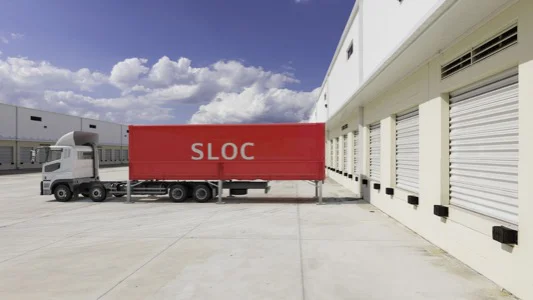Did you find this article helpful for what you want to achieve, learn, or to expand your possibilities? Share your feelings with our editorial team.


Nov 18, 2021
TECH & DESIGNUsing QR Codes to link blockchain with physical things
Preventing data falsification in mobility field and ensuring reliable traceability for commercial products
-
Solution Planning for Smart City Dept.Tatsuya Okabe
Tatsuya Okabe focused on material strength and fracture mechanics during his university undergraduate and graduate studies. He developed an operation management system for a railway company and undertook basic research on CAE, optimization, and the brain, as well as basic AI research, before joining DENSO in 2017 as a mid-career hire. Okabe initially coordinated technology-related operations for the AI R&I Div. and later went on to launch DENSO’s blockchain R&D efforts. He is currently a Project Director of the Information Traceability Sect. of the Solution Planning for Smart City Dept. In 2004, he completed a doctoral degree in engineering (doktoringenieur) at Bielefeld University in Germany.
-
Solution Planning for Smart City Dept.Xin Xu
Xin Xu came to Japan as a participant in the Hokkaido University Short-Term Exchange Program (HUSTEP). He studied speech recognition and voice dialog systems during his university and graduate school years before joining a leading communication company to carry out R&D on multimodal interaction systems, pursue collaborative business endeavors with overseas companies, and participate in AI- and IoT-business planning. In 2017, Xu joined DENSO as a mid-career hire and is currently in charge of connected car technology and blockchain technology development. He received his doctoral degree in engineering from Hokkaido University in 2016.
-
Solution Planning for Smart City Dept.Yawen Huang
Yawen Huang was motivated by an interest in robots and come to Japan as an exchange student. She studied mechanical engineering and robotics during her undergraduate and graduate student years. Huang was previously in charge of the transition to mass production operations and new B2C (business-to-consumer) development at a leading manufacturer of disaster management tools before joining DENSO as a mid-career hire in 2018 where she is now engaged in R&D on virtual simulation technology and basic blockchain technology. She completed her doctoral degree in engineering in 2012 at the Tokyo Institute of Technology.
Blockchain has become widely known for its use with cryptoassets, but the technology actually has practical applications in a wide variety of fields. DENSO Corporation is using mobility-related blockchain along with QR Codes and other technologies to build a traceability system. Let’s take a look at how DENSO is working to link data and physical things together, and at the new possibilities this approach creates.
Contents of this article
The relationship between DENSO and blockchain
— Most people think of DENSO as an automotive component manufacturer, so I was surprised to find out that you also work with blockchain. How are mobility and blockchain related?
Xin Xu:Modern-day vehicles use various sensors, dashboard cameras and other such devices which gather enormous quantities of data that are updated every few dozen milliseconds. In the future, we expect this data will find many uses in various businesses. A car’s mileage, for example, is an important number when determining the price of a used car. Auto insurance companies are also looking to utilize driving data for their business. However, inevitably some people will try to delete or falsify such data to gain an advantage, which is why we need to come up with countermeasures to prevent data tampering.
This can be done in various ways, and in recent years an increasing number of businesses are considering using blockchain technology. When using a blockchain configuration, data is distributed across and managed by participating nodes in order to make tampering extremely difficult.
Unfortunately, existing blockchain technology cannot be readily applied as-is within the mobility field, because it requires blockchain nodes to be network-connected at all times. This is not always possible with vehicle-based communication, which sometimes suffers dropped network connections.
A blockchain’s distributed ledger function may not work when a network connection has been lost, and any tampering with data stored in the vehicle will likely go undetected during that offline period. Furthermore, electronic control units (ECUs) used in automobiles do not offer the same high performance as a personal computer or server, and therefore cannot be used for high-load calculations. That’s why DENSO has been developing a type of in-vehicle blockchain system to overcome these problems.
In recent years, CPUs have been programmed to store critical data in special sections of memory featuring added protection, such as facial recognition data, fingerprint authentication data and the like for smartphones and other devices. With vehicle-use blockchain, the hash value* received prior to a network connection loss can be stored in the same area.
* A “hash value,” or simply “hash,” is a value generated by a mathematical function (hash function) based on the original data. The same hash is always generated by the original data, but it is virtually impossible to reproduce the original data based on the hash. Moreover, if the original data is altered, the hash will change.
In addition, the vehicle-related data processing program can also be used to protect the hash. As a result, any falsification of data or programs used within vehicles can easily be detected.
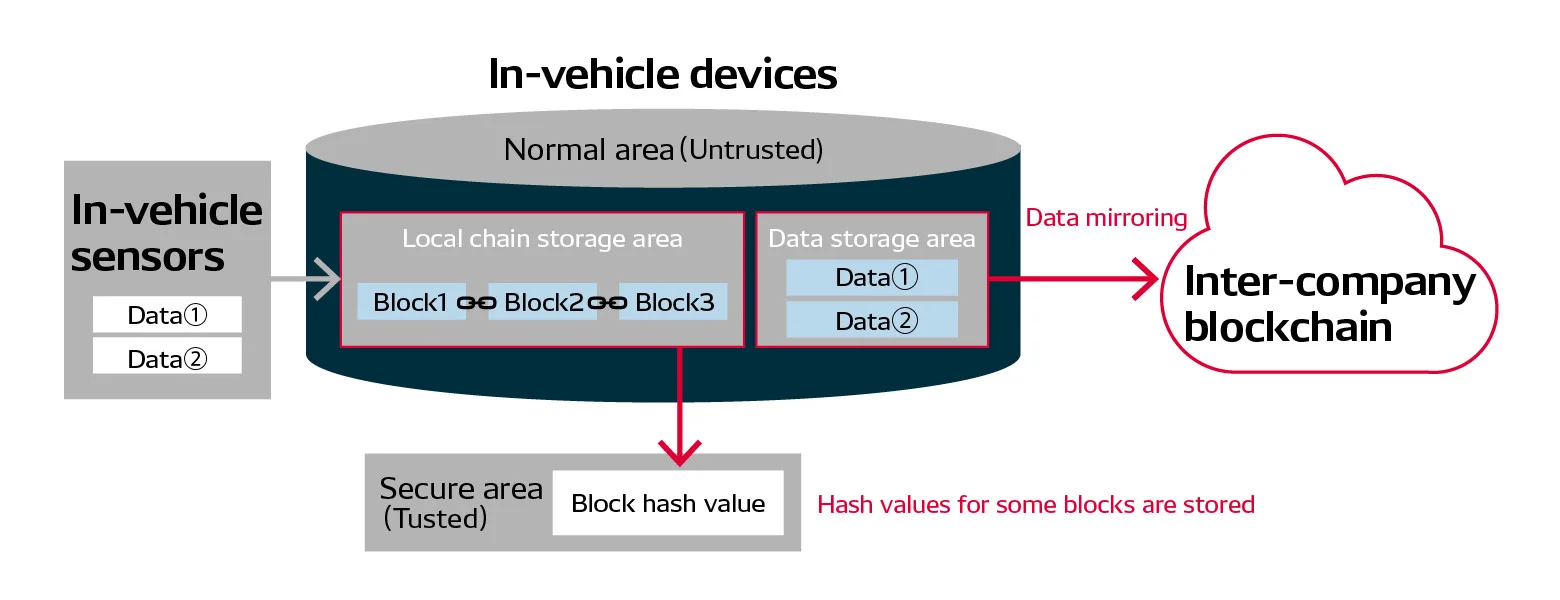
— If data tampering during a network disconnection can be fully prevented, then will a wide range of applications be possible?
Xu: Edge computing, where data is processed on the device rather than being sent to a cloud network, has become increasingly common in recent years. We think blockchain can be useful for protecting data related to the factory's production information, design drawings and other important information stored on edge servers.
Tatsuya Okabe: When using network-connected vehicles, smart appliances and other such products, there is likely some data that, for personal reasons, users would prefer to not store on a cloud network. In addition, some drivers may turn off a vehicle’s communication function when they are in a hurry and need to drive more quickly, which will lead to major losses for insurance companies who calculate rates based on driving information. In this case, the untransmitted data would need to be kept and protected by the hardware.
— In which fields other than mobility does blockchain have potential applications?
Okabe: I believe traceability is becoming increasingly important for many things such as industrial products and food products, so that people can trust what they are buying. Currently, DENSO is developing blockchain technology for supply chain applications and other such uses.
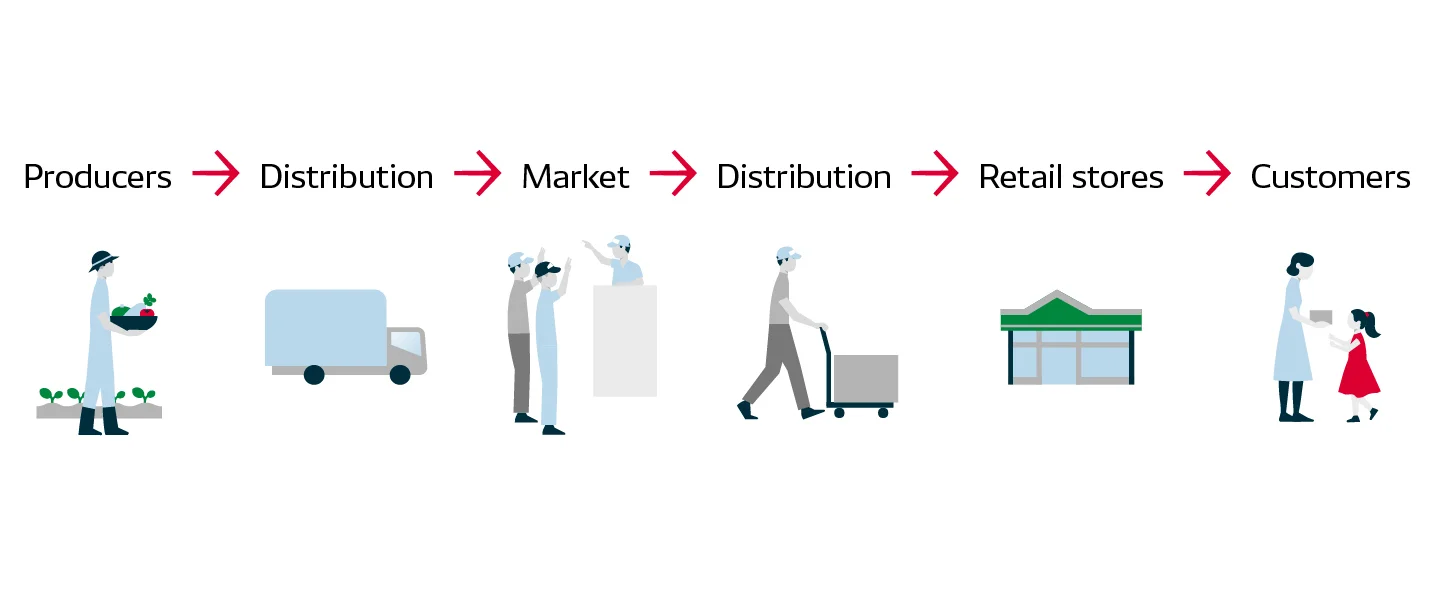
Linking blockchain-stored data to physical things
— I often hear people talk about using blockchain in transactions with physical products and also for traceability, but I wonder about this approach. I understand that it is extremely difficult to tamper with blockchain-protected data, but I do not understand how things that physically exist in real life can be tied to blockchain data. How can we be sure that the real-life product is actually compliant with the information stored in blockchain data?
Okabe: We were worried about the same thing, so we tested various approaches. One idea was to photograph each object and store the image files as blockchain data, but many products, including industrial products, tend to look the same and are hard to tell apart in photographs. Another traceability method is blowing diamond dust across each object and then shining light on it and registering the distinct, reflected patterns, but that would be difficult to do with food products.
One startup found a good way to achieve food-product traceability using seaweed: Seaweed is mixed into the food product cleansing liquid so that the residual seaweed DNA left behind can be used to identify where a product was produced. It’s a really simple, reliable way to link physical things with data.
At any rate, when searching for a good method to use at DENSO, we recalled the QR Code technology that we had developed 25 years earlier. Using QR Codes together with blockchain seemed like a secure way to solve our problem.
— How do you use QR Code technology in the traceability system currently under development at DENSO?
Okabe: A supply chain participant—a materials manufacturer, let’s say—could store timestamped data relating to materials, production history and so forth in a blockchain system and then print out a corresponding QR Code to be used as the hash. The company which then receives the materials for further processing could scan the QR Code using a reader, and after processing the materials, store data for the materials in a similar manner within the blockchain and, again, print their own QR Code for use as the hash. This creates blockchain-based traceability for the supply chain. Producers involved at any stage of the process can simply scan the QR Code to store blockchain-protected information, and end users can scan the QR Code to easily review traceability information for a product.
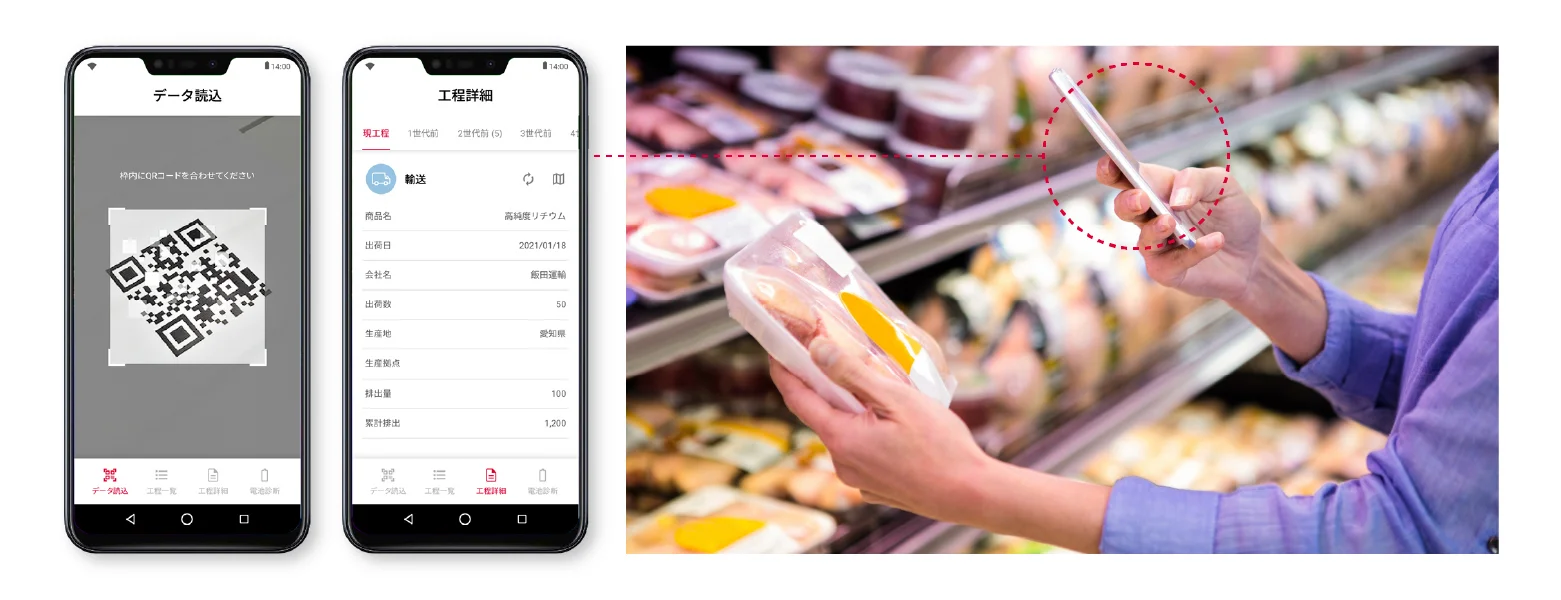
— Surely someone could just take a photograph of a QR Code on one product, print out a copy, and then affix it to a different product?
Okabe: We have a number of technologies to prevent such abuse. One of these is a type of QR Code with built-in anti-forgery protection (patented DENSO WAVE technology), which is already being used by Okinawa Prefecture’s Yui Rail (Okinawa Urban Monorail) and other companies. For this type of QR Code, a special kind of ink is added on top of the printed QR Code so that it appears solid-black when photocopied. Another preventive measure is detection of repeated QR Code patterns. If someone were to make a large number of copies of a certain QR Code, then it would end up being used in many locations. This widely repeated, identical code could be detected, and once it became obvious that a traceability QR Code was being abused, then all copies on the market would be treated as counterfeits.
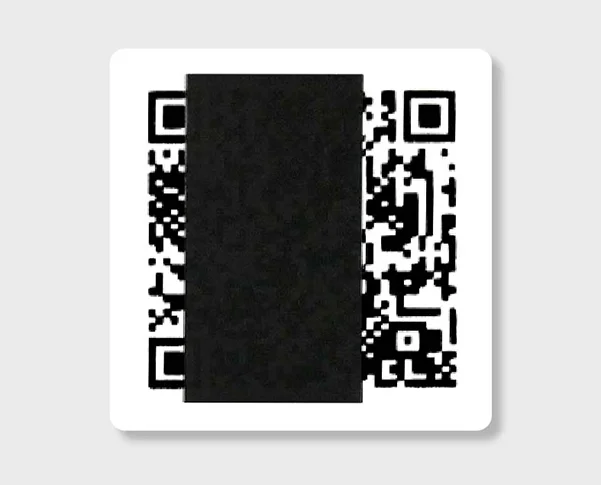
— Can a traceability system using QR Codes and blockchain be easily integrated into existing supply chain management systems?
Okabe: Because technologies like QR Codes and barcodes are already used in product management systems, simply adding a new-format QR Code could cause incompatibility issues and system problems. In fact, we encountered this exact problem during our verification testing, which is why we designed the traceability-use QR Codes to hold multiple types of information. Different information is acquired when a QR Code is read by a standard scanner device or mobile app, and when it is read by a dedicated traceability information app.
— How are the two types of QR Code structured differently?
Okabe: The basic principle is extremely simple. A standard QR Code or barcode uses black and white patterns only, whereas a traceability-use QR Code also uses grays and colors in its patterns. A standard scanning device reads colors that are brighter than a predefined threshold value as white, and those darker than a certain value as black, thus interpreting all shades as only black or white. A traceability-use scanner, on the other hand, can detect the shades of gray and colors in each pattern, meaning it reads information not possible with a standard scanner. With this approach, traceability-use QR Codes can be designed to work with standard scanners for existing product management systems while simultaneously carrying traceability data, thus minimizing the need to modify existing systems.

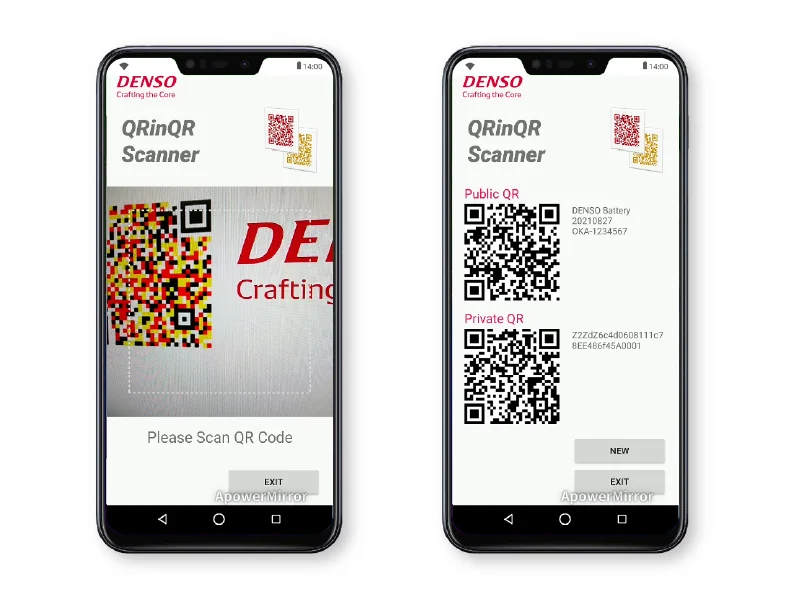
Laying the foundations for future blockchain applications
— I believe various blockchain technologies are being developed for Bitcoin, Ethereum and other blockchain-based systems. What types of technology is DENSO using?
Yawen Huang:The suitability of individual technologies depends on the intended application. For mobility services, large numbers of vehicles have to be managed at once, which makes processing performance and scalability important. By carefully determining which elements and performance factors will be needed in our anticipated applications, we can choose appropriate blockchain technologies and thus optimize our approach to reduce operating costs, while also giving priority to implementing the most important processes and fine-tuning things.
Okabe: Right now, we are using Ethereum for the traceability system currently under development at DENSO. In the future, we are considering switching to Hyperledger Fabric or another option. Today, businesses use different blockchain technologies in accordance with their specific field, but we believe that, in the future, these various types will be brought together and linked to enable new services. With this in mind, we are laying the foundations for compatibility with a diverse range of other blockchain technologies.
Huang: For example, in operations that combine financial blockchain and mobility-field blockchain technologies, data may be exchanged for other data or for currency among the two systems, in which case disparate blockchain databases would have to be connected and data transferred back and forth between them. We are researching this type of interoperability.
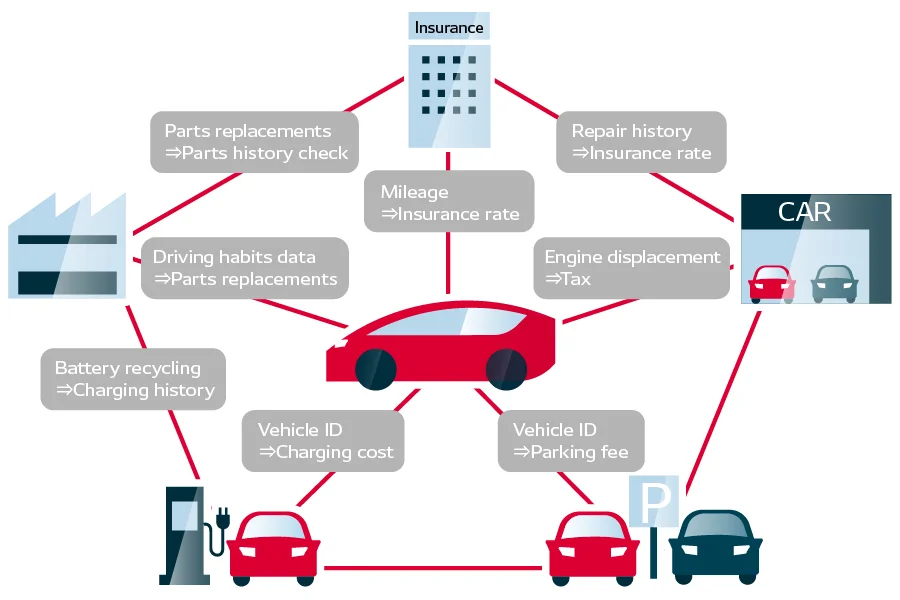
— Mr. Okabe and Ms. Xu, you were both originally involved in AI research. How do you think blockchain and AI will be interlinked in the future?
Okabe: A blockchain is a database designed to store and protect data. We are trying to come up with ways of using that data to provide customers with the services they want. I talked earlier about detecting counterfeit QR Codes used for traceability, which is one example of using AI in this field. Regarding mobility, we believe AI has various possible applications, such as for prediction of mobility service and product value, and provision of advice and tips on mobility usage.
Xu: I also believe AI could be used in data processing for vehicle-based blockchains. A diverse array of data can be obtained from vehicles, but because these data volumes are so large, they may overwhelm our systems if we try to save everything to memory. To solve this, we can use AI-based analysis to identify meaningful data from among the vast quantities of data received, and then store only the useful data in the blockchain.
Blockchain is the “mixed martial arts” of software engineering
— Your comments suggest that DENSO is developing not only blockchain technologies, but also smartphone apps, cloud-based services, AI analysis techniques, and many other things.
Okabe: With standard software development—particularly for hardware-integrated software—development starts only after determining the final specifications. With blockchain software development, however, this approach would not make us market-competitive. It’s necessary to carry out development quickly, adapting to changing applications, customer needs and other such factors. We must use an agile development approach and make updates as we go along.
Xu: Blockchain is still a new technology, so there aren’t many examples to refer to. Therefore, it’s not possible for anyone to write product specifications before we start development. We just have to try making and releasing something that works in order to obtain feedback from users.
Okabe: When we are not sure which business direction to take, or how to formulate detailed specifications, there is no point in thinking about things like the end value of software or how to approach the overall design of a system. We always do our best, but when there’s something we don’t know or understand, we have to admit that we don’t know and get on with making something anyway. There have been times when we’ve spent about two weeks making some new software, and only afterward watched it at work while trying to come up with potential applications and determine its value.
— Your team members have diverse international backgrounds, don’t they?
Huang: Regarding our team in Japan, about half of the members are from Japan and half from other countries. We also work closely with the United States-based team in development operations. In general, conversation throughout the department is in English, which can be difficult for new members when they first join us. However, team members study and practice English together once a week, and the Japanese staff also teach their language to non-Japanese members. As a result, all of us are able to give presentations in both English and Japanese.
Okabe: Above all, the desire to use one’s skills in order to make customers happy and deliver better services to the world is key. If you possess this mindset, DENSO can provide the education and learning opportunities you need to grow, and you will find yourself making steady progress. For an engineer, this is a fun and fascinating place to work.
COMMENT
Changing your "Cant's" into "Cans"
Where Knowledge and People Gather.


